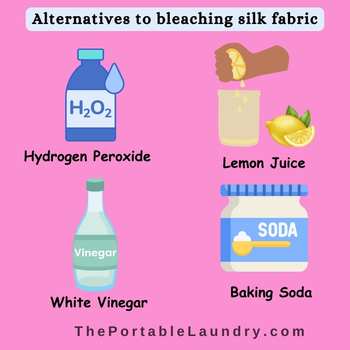Bleach, even in diluted form, may erase the color permanently and induce yellowing. After being exposed to bleach, silk fibers tend to get weakened and the fabric becomes brittle. It is recommended that you apply a mild stain remover or have the silk professionally cleaned if stains appear.
Regardless of the bleaching type, i.e., chlorinated, non-chlorinated, or oxygen bleach, it’s best to avoid bleaching silk fabrics altogether.
Key Takeaways
- You should never use bleach on silk fabrics, as it may cause irreversible damage and discoloration.
- Silk is a delicate material made of protein fibers, and bleach can break down these fibers and cause them to weaken.
- If you need to brighten or remove stains from silk fabrics, there are other methods that are safer for the fabric such as using mild detergent, specialized silk detergents, or a vinegar solution.
Table of Contents
How to bleach silk safely and effectively?
Silk, with its natural coloring matters mainly found in sericin, undergoes a transformative journey during the bleaching process.
This complex fabric carries pigments of yellow, green, and brown, which are eliminated during degumming.
However, what might surprise many is that silk fabrics made from yellow raw silk, even after degumming, aren’t perfectly white but exhibit a subtle cream hue due to residual pigments absorbed by fibroin.
Bleaching silk is an art in itself, with two primary techniques: reductive and oxidative bleaching.
Reductive Methods
Reductive methods involve agents like Sulphur dioxide and sodium hydrosulphite but may result in color restoration.
Oxidative Methods
Oxidative bleaching, primarily using hydrogen peroxide, is the preferred choice.
The process demands specific temperature and pH conditions for optimal results, ensuring that the silk retains its natural luster.
Intriguingly, chlorine-based bleaching agents are avoided in this delicate process to prevent any undesired effects on the silk’s fibroin structure.
For those seeking the secret to pure white silk, hydrogen peroxide emerges as the star player in this age-old textile transformation.
Alternatives to bleaching silk fabric

Hydrogen Peroxide
When it comes to bleaching silk using hydrogen peroxide, make sure to test the fabric in an inconspicuous spot before bleaching the entire garment.
Hydrogen peroxide should always be mixed with water to make a weaker solution, and the fabric shouldn’t be left in the solution for too long.
Lastly, don’t forget to add a mild detergent to the final rinse cycle to help get rid of any of the solution’s leftover compounds.
- To start, you will need to gather your supplies such as hydrogen peroxide, water, dish soap, and a bucket. Make sure to wear protective gloves regardless of the solution you are using.
- Next, mix one part hydrogen peroxide with four parts of slightly hot water in the bucket and add a few drops of dish soap (Mix the solution well).
- Now it’s time to add your silk fabric to the mixture and make sure that the fabric is completely submerged. Keep it submerged for approximately 30 minutes before you decide to rinse it.
- After 30 minutes, work on the stained areas with your fingers and remove the silk fabric from the bucket.
- Give it a final rinse using cold water and let the silk garment air dry naturally in a shady spot.
Vinegar
Just fill a bucket or a tub with warm water and add a cup of distilled vinegar to it.
Next, mix the solution well, and then place the silk garment into the solution for soaking.
Leave it for 30 minutes, and then rinse it a couple of times using clean and cool water.
Hang the silk fabric away from direct sunlight so it can dry naturally.
Once dried, your silk garment should appear brighter and fresher.
Baking soda
Since baking soda does not contain any harmful chemicals, it is a far safer and more environmentally friendly option for getting the stains out of silk fabrics safely and effectively.
Because baking soda is alkaline, it may help break down the molecules that make up a stain.
Lemon juice
When it comes to safely removing the stains from silk, lemon juice is a far better option than bleach.
Lemon juice is a natural cleaner and is not as harsh or abrasive as bleach. It’s a lot gentler on the material and helps lessen the stain without ruining the fibers.
In addition to removing the stain, the citric acid in lemon juice also makes the cloth seem brighter and whiter.
Simply apply some fresh lemon juice to the stain and rub it in with your fingers.
Let the lemon juice solution sit for a few minutes, and then wash as usual.
Final Thoughts
Bleaching is a process that employs chemical agents to remove the color from fabric for a variety of purposes, including whitening the fabric or removing stains.
When silk is bleached too often, it loses its color or fades, the fibers get weaker, the fabric shrinks, it gets stiffer, and it can even tear.
To remove color or stains or to brighten an expensive silk garment, it is best to take it to the nearest laundry experts.
That being said, if you decide to take the DIY approach, it’s highly recommended that you go through the care label once before choosing the right method to wash your silk fabric.
You May Also Like
- How to remove food stains from silk garments?
- Does silk fabric shrink in a clothes dryer?
- Should you wash silk fabrics in the washing machine?
- Is it safe to bleach rayon fabrics? (Tips for bleaching rayon)
- Can you wash Wedding Gowns in a Washing Machine?
- Can you sublimate on modal fabric? (Answered)
- Can You Wash Artificial Flowers In Washing Machine?
- Can you wash sleeping bags in a washing machine?
- Can outdoor cushion covers be machine washed?
- Can Upholstery Fabric Be Washed In Washing Machine?
- Can Minnetonka Moccasins be washed in the washing machine?
